Edelstein-Keshet L. Mathematical Models in Biology
Подождите немного. Документ загружается.


466
Spatially
Distributed
Systems
and
Partial
Differential
Equation
Models
A
somewhat familiar equation
results
from
these substitutions:
This equation contains
one
term that resembles
diffusion
and a
second that resembles
convective transport. This suggests some kind
of
analogy between
the
process
of
cellular
maturation
and
physical particle
motion.
We
explore this more
fully
in the
following
subsection
and
discuss several details
in the
problems.
Analogies
with
Particle Motion
To
approach
the
same probl
in a
more informal way,
we
abandon tempora ly
the
detailed discrete derivation
and
view
the
process
of
cellular maturation
as a
continu-
ous
transition
from
birth
to
maturity
of the
cell.
It is
rather natural
to
picture cell
maturation
as
"motion"
of the
cell
along
a
scale
a. We now
make
the
analogy more
precise.
Consider
the
physical motion
of
particles
in a
one-dimensional setting.
For
x
= the
distance
and
c(x,
t) = the
density
of
particles (per
unit
length)
we
derived
a
conservation equation
(24 in
Chapter
9) to
describe
collective
particle motion.
If
par-
ticles move
at
some velocity
t;,
then
the
displacement
of
each individual particle
might
be
described
by
Collectively, their
flux
would then
be
Now
replace
(1)
physical distance
in
space
by
"distance"
along
a
scale
of
mat-
uration
(x
—»
a) and (2)
density
of
particles
in
space
by
density
of
cells along
the
maturation
cycle [c(x,
t)
—»
n (a,
t)]. Then
the
velocity
of a
particle would corre-
spond
to the
rate
of
change
of
cellular maturity:
In
other words,
we
make
the
connection
that
v(x,
t)
—>
v(a,
t).
This means that
the
number
of
cells that mature through
a
stage
a
0
per
unit time (the cell
flux)
would
be
that
is, J
c
-* J
n
-
Finally,
a
local loss
of
particles
<r
c
(x,
t)
would
be
analogous
to a lo-
cal
cellular
loss
rate
cr
n
(a,
t).
This could stem
from
a
mortality /it, where
/A
might
be
a
function
of the
cellular maturity:
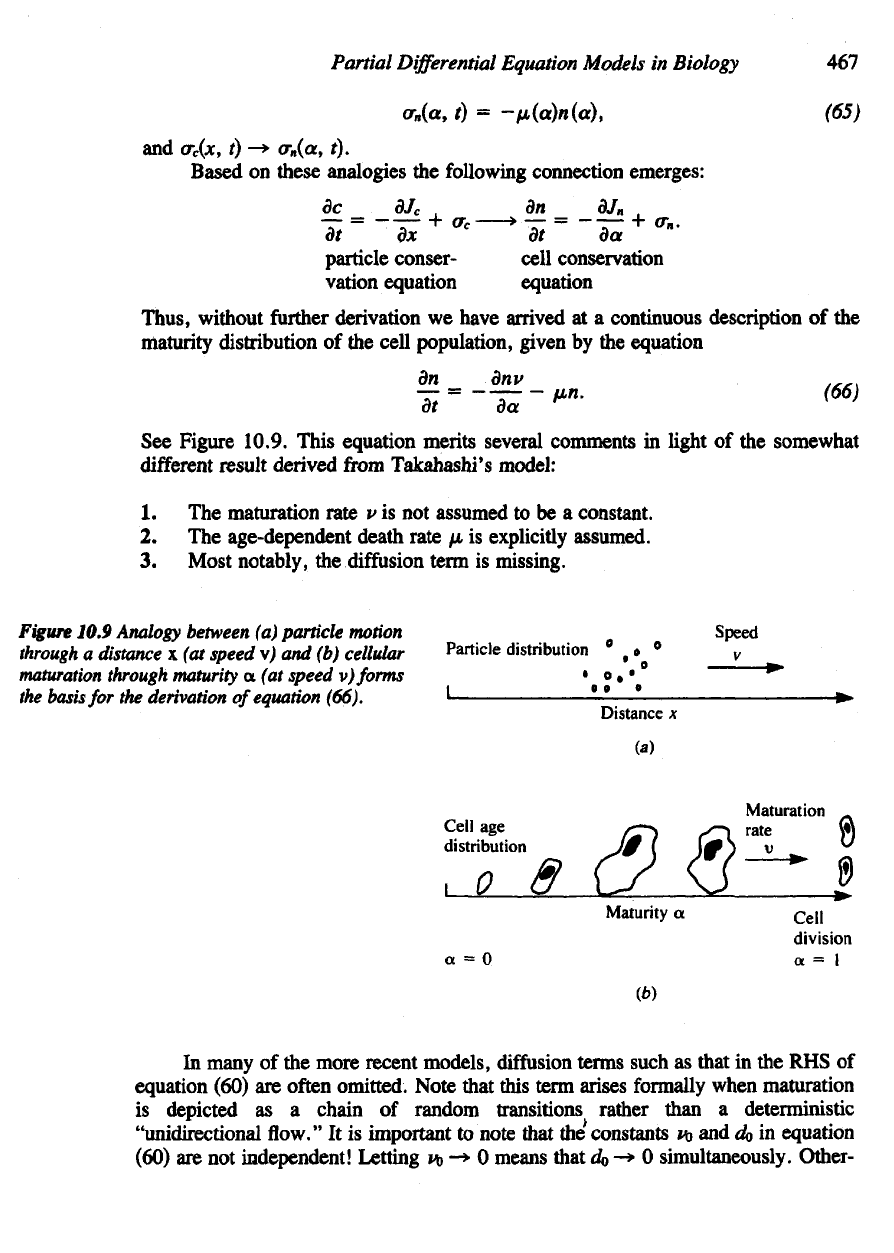
and
a
c
(x,
t) -»
(r
n
(a,
t).
Based
on
these analo s
the
following connection emerges:
Thus, without
further
derivation
we
have arrived
at a
continuous description
of the
maturity
distribution
of the
cell
population, given
by the
equation
See
Figure 10.9. This equation merits several comments
in
light
of the
somewhat
diffe
lt derived
from
Takahashi's model:
1. The
maturation rate
v is not
assumed
to be a
constant.
2. The
age-dependent death rate
fjL
is
explicitly assumed.
3.
Most notably,
the
diffusion
term
is
missing.
Figure
10.9 Analogy between
(a)
particle
motion
through
a
distance
x (at
speed
v) and (b)
cellular
maturation through maturity
a (at
speed
v)
forms
the
basis
for the
derivation
of
equation (66).
In
many
of the
more recent models,
diffusion
terms such
as
that
in the RHS of
equation (60)
are
often
omitted. Note that this term arises formally when maturation
is
depicted
as a
chain
of
random transitions rather than
a
deterministic
"unidirectional
flow." It is
important
to
note that
the
constants
MD
and do in
equation
(60)
are not
independent! Letting
VQ
—»
0
means that
do -* 0
simultaneously. Other-
Partial
Differential
Equation
Models
in
Biology
467
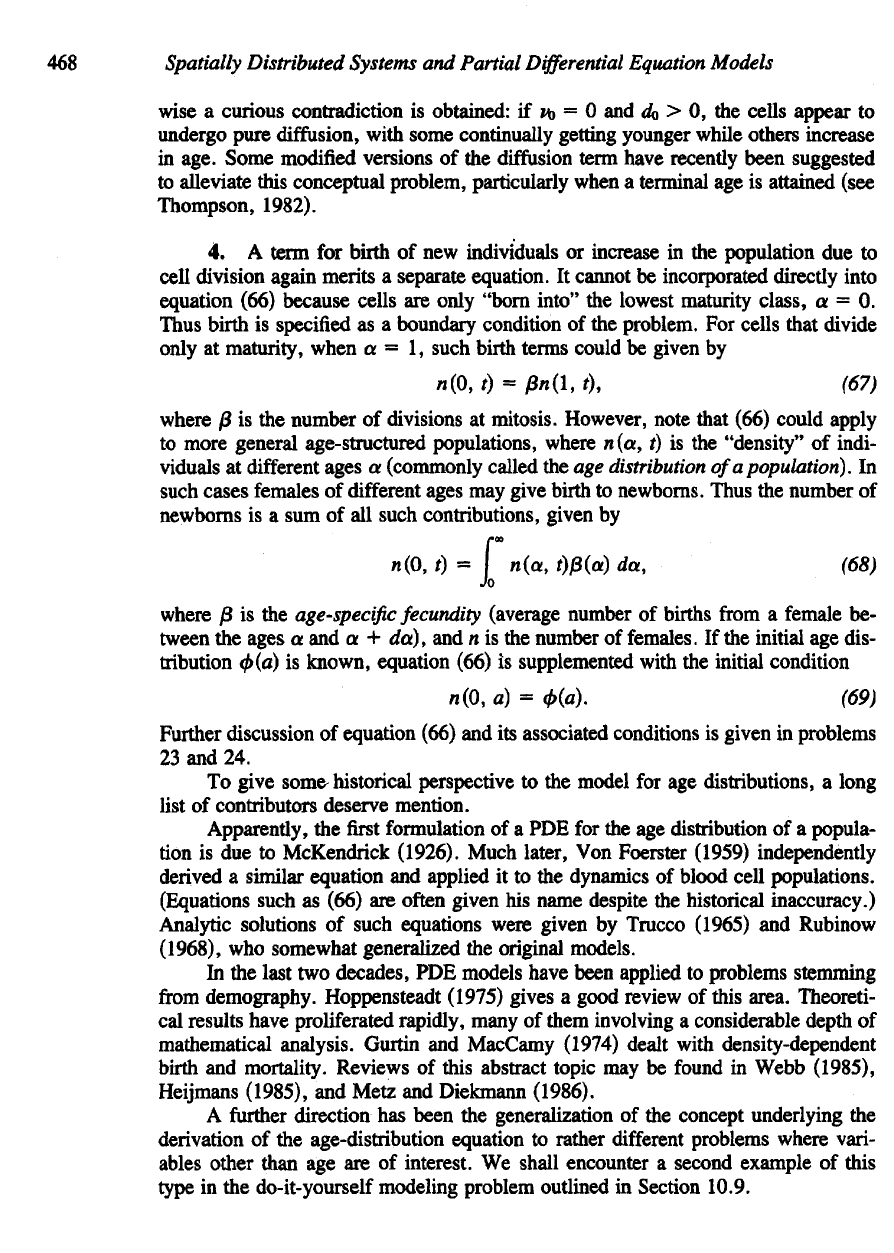
468
Spatially
Distributed
Sy
nd
Partial
Differential
Equation
Models
wise
a
curious contradiction
is
obtained:
if
VQ
= 0 and do > 0, the
cells
appear
to
undergo pure
diffusion,
with some continually getting younger while others increase
in
age. Some modified versions
of the
diffusion
term have recently been suggested
to
alleviate
this conceptual problem, particularly when
a
terminal
age is
attained (see
Thompson, 1982).
4. A
term
for
birth
of new
individuals
or
increase
in the
population
due to
cell
division
again
merits
a
separate equation.
It
cannot
be
incorporated directly into
equation (66) because
cells
are
only
"born
into"
the
lowest maturity class,
a = 0.
Thus
birth
is
specified
as a
boundary condition
of the
problem.
For
cells
that divide
only
at
maturity, when
a = 1,
such birth terms could
be
given
by
where
j3 is the
number
of
divisions
at
mitosis. However, note that (66) could apply
to
more general age-structured populations, where n(a,
t) is the
"density"
of
indi-
viduals
at
different
ages
a
(commonly called
the age
distribution
of
a
population).
In
such
cases
females
of
different
ages
may
give birth
to
newborns. Thus
the
number
of
newborns
is a sum of all
such contributions, given
by
where
j8 is the
age-specific
fecundity
(average number
of
births
from
a
female
be-
tween
the
ages
a and a +
da),
and n is the
number
of
females.
If the
initial
age
dis-
tribution
<b(a)
is
known, equation (66)
is
supplemented with
the
initial condition
Further discussion
of
equation (66)
and its
associated conditions
is
given
in
problems
23
and 24.
To
give some historical perspective
to the
model
for age
distributions,
a
long
list
of
contributors
deserve
mention.
Apparently,
the first
formulation
of a PDE for the age
distribution
of a
popula-
tion
is
due to
McKendrick (1926). Much later,
Von
Foerster (1959) independently
derived
a
similar equation
and
applied
it to the
dynamics
of
blood
cell
populations.
(Equations
such
as
(66)
are
often
given
his
name despite
the
historical inaccuracy.)
Analytic
solutions
of
such equations were given
by
Trucco (1965)
and
Rubinow
(1968),
who
somewhat generalized
the
original models.
In
the
last
two
decades,
PDE
models have been applied
to
problems stemming
from
demography. Hoppensteadt
(1975)
gives
a
good review
of
this area. Theoreti-
cal
results have proliferated rapidly,
many
of
them involving
a
considerable depth
of
mathematical analysis. Gurtin
and
MacCamy (1974) dealt with density-dependent
birth
and
mortality. Reviews
of
this abstract topic
may be
found
in
Webb (1985),
Heijmans
(1985),
and
Metz
and
Diekmann
(1986).
A
further
direction
has
been
the
generalization
of the
concept underlying
the
derivation
of the
age-distribution equation
to
rather
different
problems where vari-
ables other than
age are of
interest.
We
shall encounter
a
second example
of
this
type
in the
do-it-yourself modeling problem outlined
in
Section 10.9.
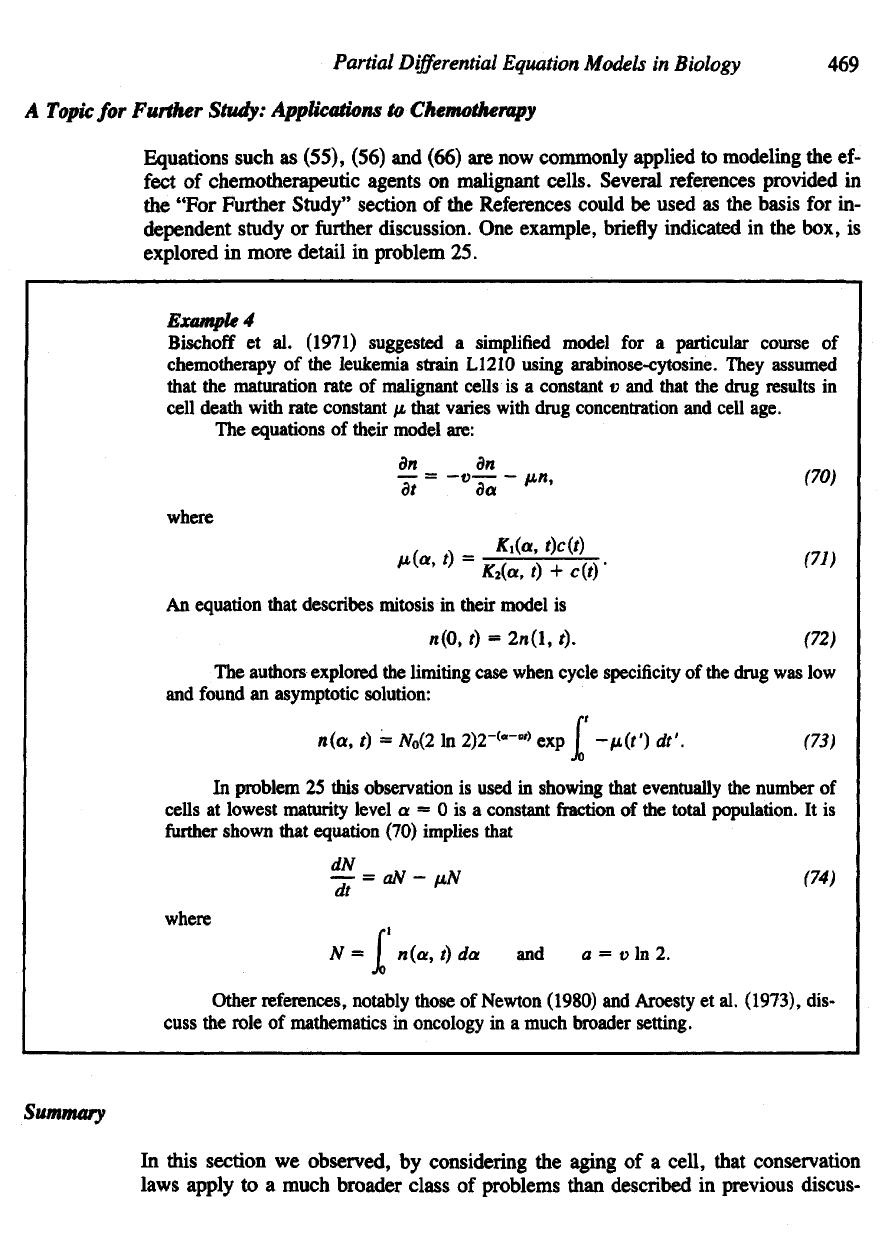
Partial
Differential
Equation Models
in
Biology
469
A
Topic
for
Further
Study: Applications
to
Chemoth y
Equations such
as
(55), (56)
and
(66)
are now
commonly applied
to
modeling
the ef-
fect
of
chemotherapeutic agents
on
malignant
cells.
Several references provided
in
the
"For Further Study" section
of the
References could
be
used
as the
basis
for in-
dependent study
or
further
discussion.
One
example,
briefly
indicated
in the
box,
is
explored
in
more detail
in
problem
25.
Example
4
Bischoff
et al.
(1971) suggested
a
simplified
model
for
particular course
of
chemotherapy
of the
leukemia strain
L1210
using arabinose-cytosine. They assumed
that
the
maturation rate
of
malignant cells
is a
constant
v and
that
the
drug results
in
cell death with rate constant
\L
that varies
with
drug concentration
and
cell
age.
The
equations
of
their model
are:
where
An
equation that describes mitosis
in
their model
is
Other references, notably those
of
Newton (1980)
and
Aroesty
et al.
(1973),
dis-
cuss
the
role
of
mathematics
in
oncology
in a
much broader setting.
Summary
In
this
section
we
observed,
by
considering
the
aging
of a
cell,
that conservation
laws
apply
to a
much broader
class
of
problems than described
in
previous discus-
The
authors explored
the
limiting case
when
cycle specificity
of the
drug
was low
and
found
an
asymptotic solution:
In
problem
25
this observation
is
used
in
showing that eventually
the
number
of
cells
at
lowest maturity level
a = 0 is a
constant fraction
of the
total population.
It is
further
shown that equation
(70)
implies
that
where
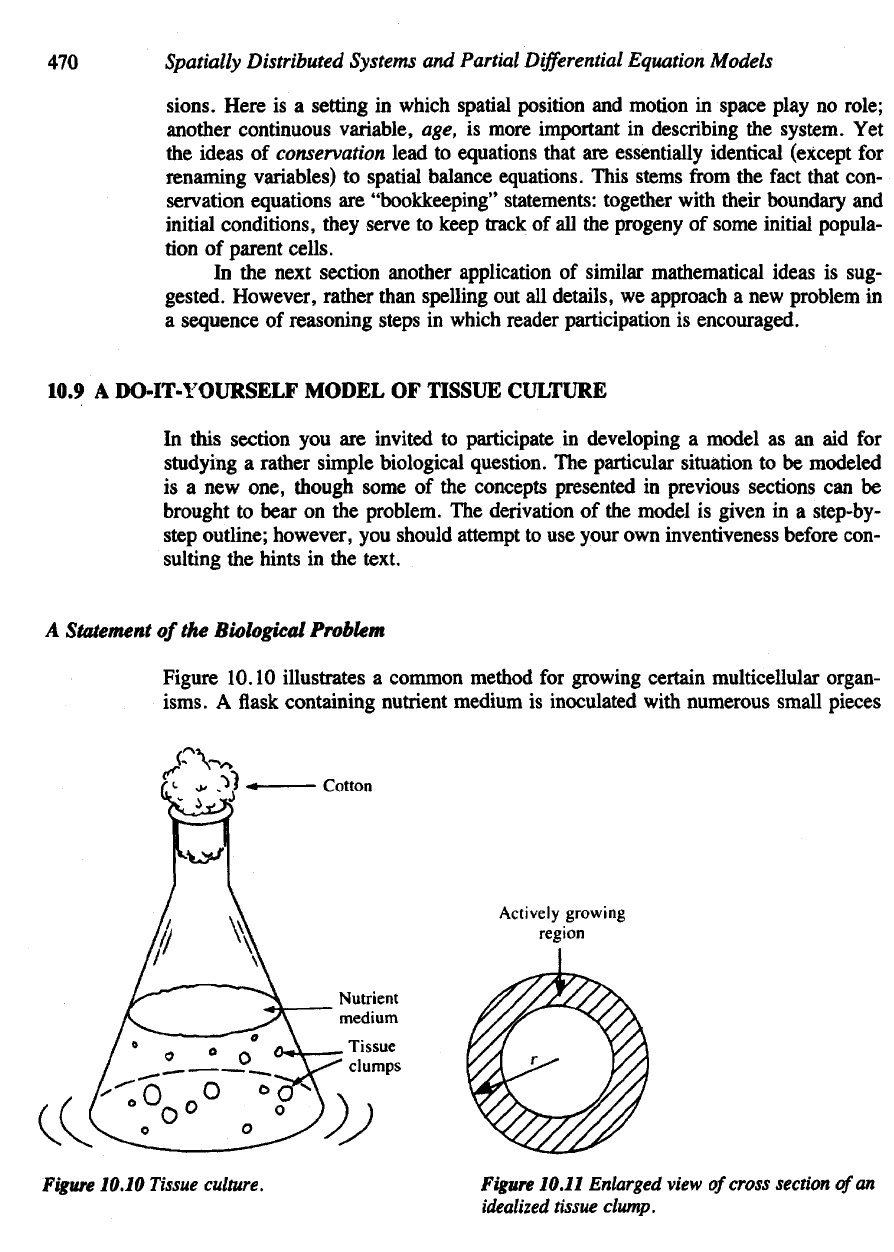
470
Spatially
Distributed
Systems
and
Partial
Differential
Equation
Models
sions. Here
is a
setting
in
which spatial position
and
motion
in
space play
no
role;
another continuous variable, age,
is
more important
in
describing
the
system.
Yet
the
ideas
of
conservation lead
to
equations that
are
essentially identical (except
for
renaming variables)
to
spatial balance equations. This stems
from
the
fact
that con-
servation equations
are
"bookkeeping"
statements: together with their boundary
and
initial conditions, they serve
to
keep track
of all the
progeny
of
some initial popula-
tion
of
parent
cells.
In
the
next section another application
of
similar mathematical ideas
is
sug-
gested.
However, rather than spelling
out all
details,
we
approach
a new
problem
in
a
sequence
of
reasoning steps
in
which reader participation
is
encouraged.
10.9
A
DO-IT-YOURSELF MODEL
OF
TISSUE CULTURE
In
this secti
you are
invited
to
participate
in
developing
a
model
as an aid for
studying
a
rather simple biological question.
The
particular situation
to be
modeled
is
a new
one, though some
of the
concepts presented
in
previous sections
can be
brought
to
bear
on the
problem.
The
derivation
of the
model
is
given
in a
step-by-
step outline; however,
you
should attempt
to use
your
own
inventiveness before con-
sulting
the
hints
in the
text.
A
Statement
of
the
Biological Problem
Figure 10.10 illustrates
a
common method
for
growing certain multicellular organ-
isms.
A
flask
containing nutrient medium
is
inoculated with numerous small
pieces
Figure
10.10 Tissue culture.
Figure
10.11 Enlarged view
of
cross section
of
an
idealized
tissue clump.

Partial
Differential
Equation
Models
logy
471
or
clumps
of
tissue,
which
may
each consist
of
many
cells.
Provided conditions
are
right
(such
as
plentiful nutrient), each
of the
pieces
will grow. Eventually they
may
be
harvested
and
used
in
performing biological experiments.
Question
Suppose
the
initial biomass
is
known. What will
be the
total biomass
at
some later
timer?
Step
1: A
Simple
Case
We
start
by
making some drastically simplifying assumptions about
the
geometry
of
the tissue
clumps:
Assumption
la. All the
clumps
are
spherical.
Assumption
Ib. All
pieces
have
the
same radius
r
(see Fi 10.11).
At
this point some information about
how the tissue
pieces
grow
is
required.
(This would generally come
from
empirical observations.)
Often
one finds
that
be-
cause
the
core
of a tissue
particle
is not
exposed
to the
nutrient medium, active
growth
can
take place largely
at its
surface,
so
that
the
volume
of a
single spherical
clump, V(t), changes
at a
rate that
is
proportional
to its
surface area, SO).
Probl
1
(easy)
Relate
this
information
to the
radial
growth
of the
particle.
Answer
Using
the
formulae
for the
volume
and the
surface
area
of a
sphere,
and
the
relation
we
get
Differentiating
r
3
and
cancelling
a
factor
of
4irr
2
from
both
sides,
we get
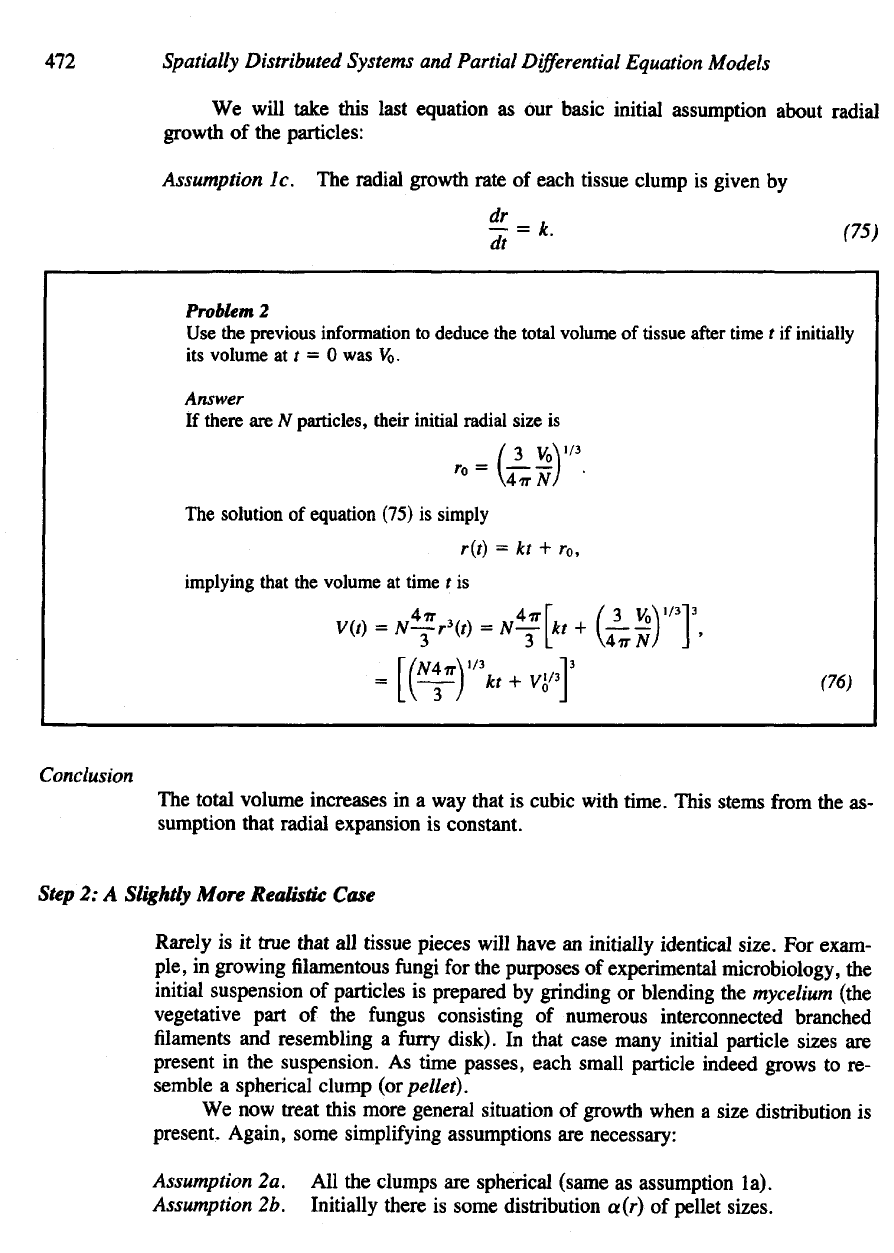
472
Spatially
Distributed Systems
and
Partial
Differential
Equation
Models
We
will take this last equation
as our
basic initial assumption about radial
growth
of the
particles:
Assumption
Ic. The
radial growth rate
of
each tissue clump
is
given
by
Problem
2
Use the
previous information
to
deduce
the
total volume
of
tissue
after
time
t if
initially
its
volume
at t = 0 was
Vb.
Answer
If
there
are N
particles, their initial radial size
is
Conclusion
The
total volume increases
in a way
that
is
cubic with time. This stems
from the as-
sumption that radial expansion
is
constant.
Step
2: A
Slightly
More Realistic Case
Rarely
is it
true that
all
tissue
pieces
will have
an
initially
identical
size.
For
exam-
ple,
in
growing
filamentous
fungi
for the
purposes
of
experimental microbiology,
the
initial
suspension
of
particles
is
prepared
by
grinding
or
blending
the
mycelium (the
vegetative part
of the
fungus
consisting
of
numerous interconnected branched
filaments
and
resembling
a
furry
disk).
In
that case many initial particle sizes
are
present
in the
suspension.
As
time
passes,
each small particle indeed grows
to re-
semble
a
spherical clump
(or
pellet).
We now
treat this more
general
situation
of
growth when
a
size
distribution
is
present. Again, so mplifying assumptions
are
necessary:
Assumption
2a. All the
clumps
are
spherical (same
as
assumption la).
Assumption
2b.
Initially there
is
some distribution a(r)
of
pellet
sizes.
The
solution
of
equation (75)
is
simply
implying
that
the
volume
at
time
t is
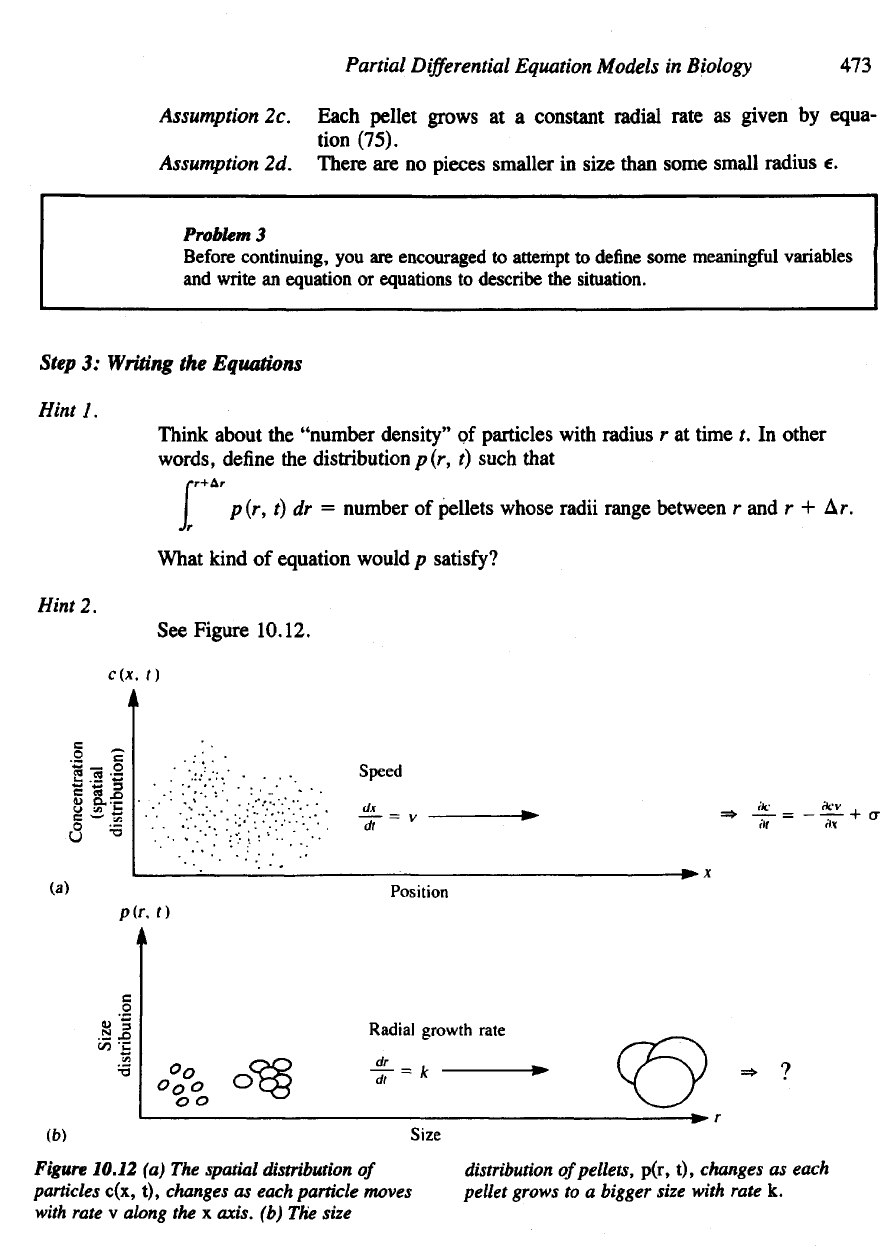
Partial
Differential
Equation
Models
in
Biology
473
Assumption
2c.
Each pellet grows
at a
constant radial rate
as
given
by
equa-
tion
(75).
Assumption
2d.
There
are no
pieces
smaller
n
size than some small radius
e.
Problem
3
Before
continuing,
you are
encouraged
to
attempt
to
define
some meaningful variables
and
write
an
equation
or
equations
to
describe
the
situation.
Step
3:
Writing
the
Equations
Figure 10.12
(a) The
spatial distribution
of
panicles c(x,
t),
changes
as
each particle moves
with
rate
v
along
the x
axis,
(b) The
size
distribution
of
pellets,
p(r,
t),
changes
as
each
pellet grows
to a
bigger size with rate
k.
See
Figure
10.12.
Hint
2.
What
kind
of
equation would
p
satisfy?
Hint
1.
Think about
the
"number density"
of
particles with radius
r at
time
t. In
other
words, define
the
distribution p(r,
t)
such that
/•r+Ar
I
p(r,
t) dr =
number
of
pellets whose radii range between
r and r + Ar.
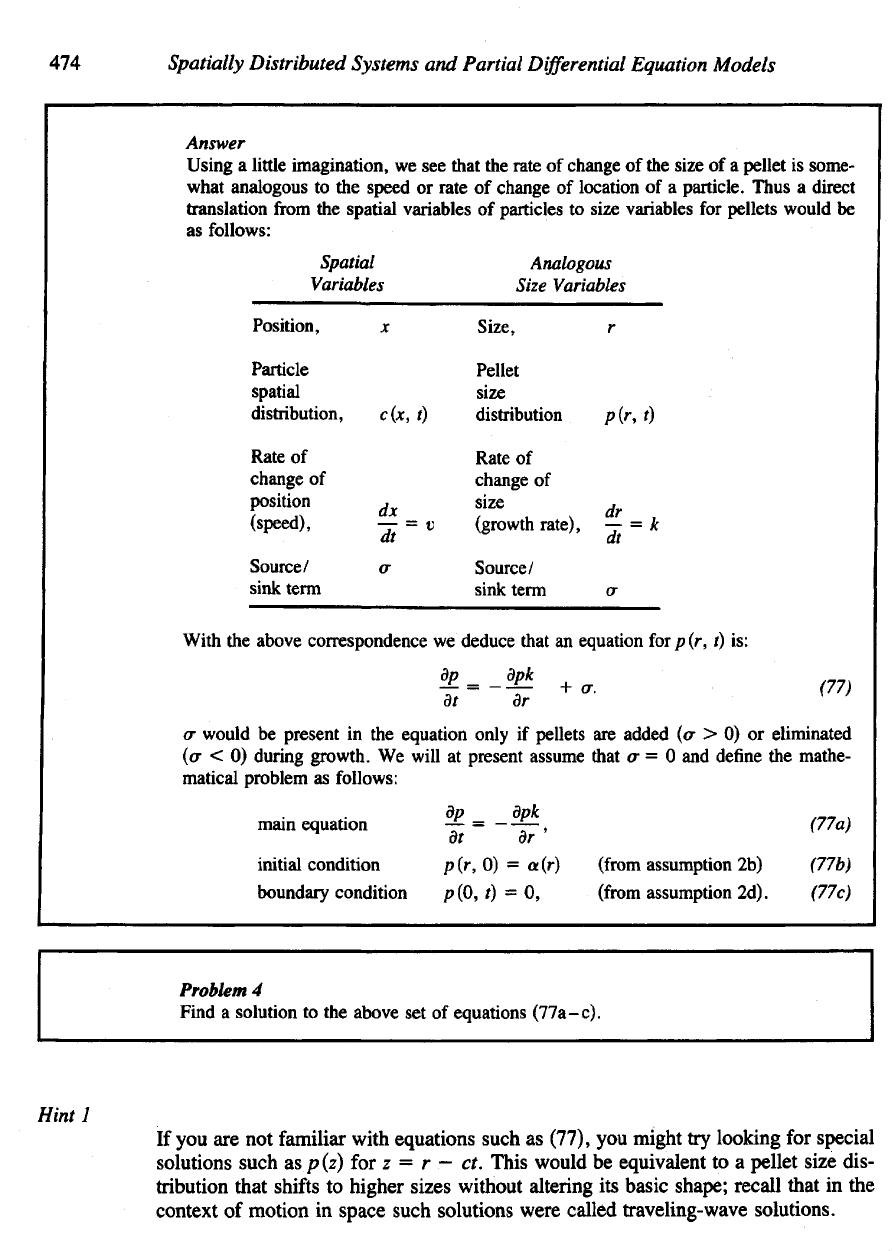
474
Spatially
Distributed Systems
and
Partial
Differential
Equation
Models
Answer
Using
a
little imagination,
we see
that
the
rate
of
change
of the
size
of a
pellet
is
some-
what
analogous
to the
speed
or
rate
of
change
of
location
of a
particle. Thus
a
direct
translation
from
the
spatial variables
of
particles
to
size variables
for
pellets would
be
as
follows:
With
the
above correspondence
we
deduce
that
an
equation
for p (r, t) is:
a-
would
be
present
in the
equation only
if
pellets
are
added
(a > 0) or
eliminated
(a < 0)
during growth.
We
will
at
present assume that
a = 0 and
define
the
mathe-
matical
problem
as
follows:
Problem
4
Find
a
solution
to the
above
set of
equations
(77a-c).
Hint
1
If
you are not
familiar with equations such
as
(77),
you
might
try
looking
for
special
solutions such
as
p(z)
for z = r — ct.
This would
be
equivalent
to a
pellet
size dis-
tribution
that
shifts
to
higher
sizes
without altering
its
basic shape;
recall
that
in the
context
of
motion
in
space such solutions were
called
traveling-wave solutions.
Spatial
Variables
Position,
x
Particle
spatial
distribution,
c(x,
t)
Rate
of
change
of
position
,
(speed),
— = t;
at
Source/
a
sink
term
Analogous
Size
Variables
Size,
Pellet
size
distribution
Rate
of
change
of
size
(growth
rate),
Source/
sink
term
r
P(r,t)
^ = *
dt
K
a
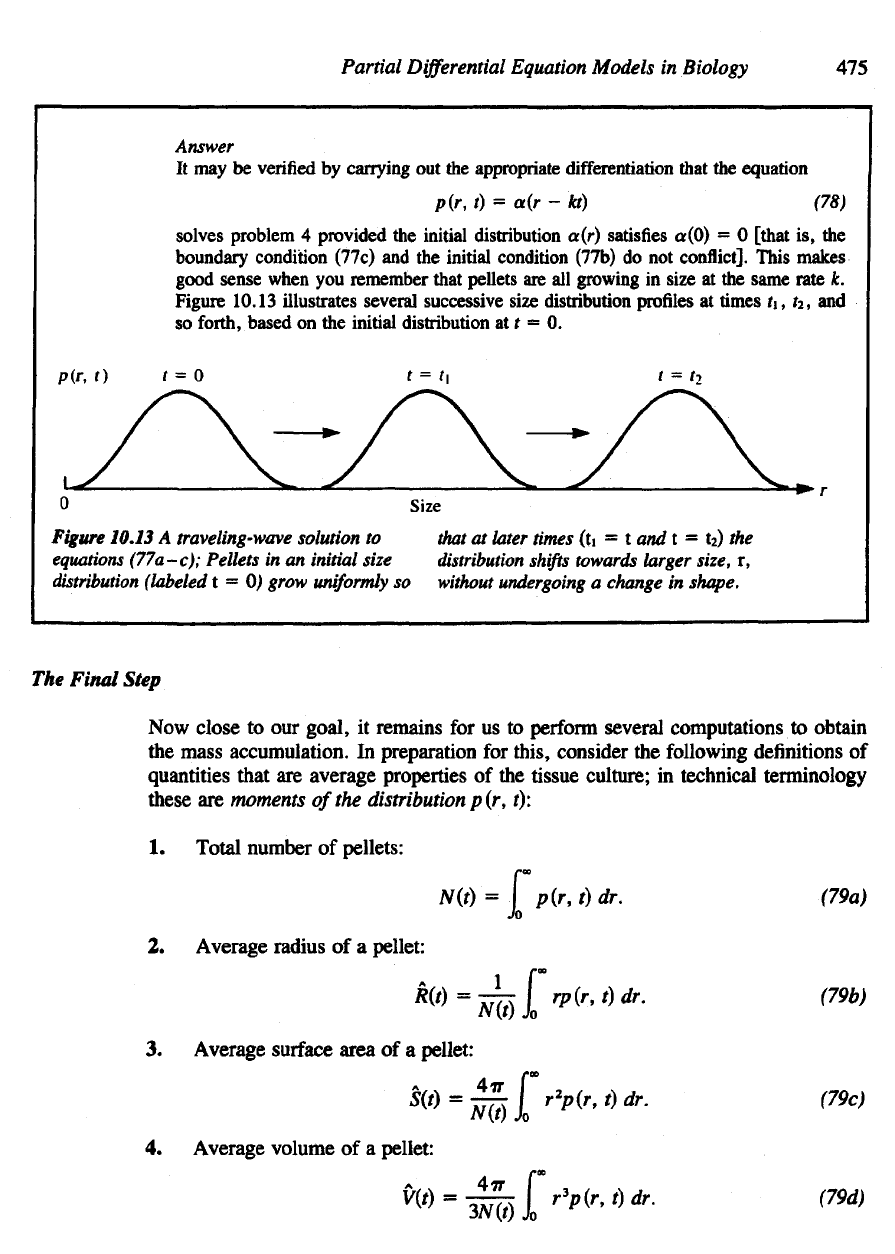
Partial
Differential
Equation
Models
in
Biology
475
Answer
It may be
verified
by
carrying
out the
appropriate differentiation that
the
equation
solves
problem
4
provided
the
initial distribution a(r) satisfies a(0)
= 0
[that
is, the
boundary condition (lie)
and the
initial condition (lib)
do not
conflict].
This
makes
good
sense
when
you
remember that
pellets
are all
growing
in
size
at the
same rate
k.
Figure 10.13
illustrates several
successive
size distribution profiles
at
times
t\, fe, and
so
forth, based
on the
initial distribution
at t = 0.
Figure
10.13
A
traveling-wave solution
to
that
at
later times
(ti = t and t = t
2
) the
equations
(77a-c);
Pellets
in an
initial size distribution
shifts
towards larger size,
r,
distribution
(labeled
t = 0)
grow
uniformly
so
without undergoing
a
change
in
shape.
The
Final
Step
Now
close
to our
goal,
it
remains
for us to
perform
several
computations
to
obtai
the
mass
accumulation.
In
preparation
for
this,
consider
the
following
definitions
of
quantities
that
are
average
properties
of the
tissue
culture;
in
technical
terminology
these
are
moments
of
the
distribution
p(r,
t):
1.
Total
number
of
pellets:
2.
Average
radius
of a
pellet:
3
rage
surface
area
of a
pellet:
4.
Average
volume
a
pellet:
